5
Section one: The fundamentals
A)
Exercise 1: Notebook Prompt
Many of you are likely familiar with the concept of “ability inequity,” which the authors of this article define as “an unjust or unfair (a) ‘distribution of access to and protection from abilities generated through human interventions’ or (b) ‘judgment of abilities intrinsic to biological structures such as the human body’.”
However, they go on to identify the following “ability concepts” that are less familiar:
1) ability security (one is able to live a decent life with whatever set of abilities one has)
2) ability identity security (to be able to be at ease with ones abilities)
How prevalent are these forms of security among disabled people you know? Or, if you identify as a disabled person, would you say your social surroundings and community foster and support these kinds of security? Furthermore, while the focus of the article is on Kinesiology programs, it is also important to reflect on how academia in general accommodates for disability. If you feel comfortable answering this question, what has been your experience of postsecondary education to date?
-OR-
The authors also observe that “Ableism not only intersects with other forms of oppression, such as racism, sexism, ageism, and classism, but abilities are often used to justify such negative ‘isms’.”
What do you think this means? Provide an example.
| I believe the authors were encapsulating the idea that many people with disabilities are seen as less than human, and commonly can be discriminated against on the basis of their ability through infantilization, and projection of incapacity. Within instances of racism, sexism, ageism and classism, these marginalized groups are already at a systemic disadvantage and require social supports to be treated fairly in society. When these identities intersect with disabilities these marginalized groups are then reduced down to their race and ability, and are not viewed as human by society due to ingrained ablism and racism. Abilities are used to justify these other negative “isms” through this reduction of their identity, where they are seen as a further social burden. Where racialized disabled people are viewed negatively due to their supports needed for their race, but then is further exacerbated by their needs at the hands of their disability. In relation to this idea, these isms stem from being apart from the social norm, that consists mainly of white, cisgender, straight, male and able-bodied. Women in this case would have sexism geared towards them as justified due to a disabled woman not fitting the concept of what a woman should look like in society. I think this justification for poor treatment due to ability status stems from their perceived “burden on society”, such as a lower SES individual needed social services on top of ability services in order to leave the house and sustain themself. The overall dehumanization of people with disabilities operates as a method of excuse when discriminating against a group for their race, gender, class or age, where care and empathy for these people is replaced with infantilization and perceived burden.
|
Exercise 2: Implicit Bias Test
Did anything surprise you about the results of the test? Please share if you’re comfortable OR comment on the usefulness of these kinds of tests more generally.
| Overall, I was not extremely surprised by my result. I had a stronger preference for physically abled people over physically disabled people, and I can attribute that to my lack of exposure to those with disabilities, and my lack of experience with them. Additionally, ingrained ableism in society perpetuates itself daily, and as an able bodied person, I am not immune to the effects of ableist power structures, perceptions and methods of thinking. While I consciously do not want to be ableist and deconstruct these ways of thinking as I realize their harm, ingrained bias and underlying unconscious thoughts and feelings are possible to still exist. I feel as though many people have a preference for what is familiar to them, and intrinsically for me, that is being able bodied. Overall though, I would like to work towards to becoming less biased and more equal and equitable with my preferences for physically abled and disabled people.
|
B) Keywords
Exercise 3:
Add the keyword you contributed to padlet and briefly (50 words max) explain its importance to you.
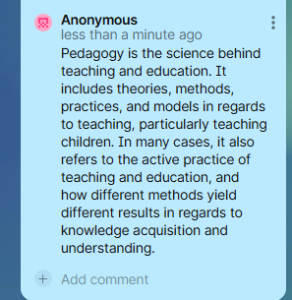
Pedagogy is important to me because I am a child and youth major, and a large portion of our teaching revolves around the practice of pedagogy, and its accompanying theories.
|
B) On Disability
Exercise 4: Complete the Activities

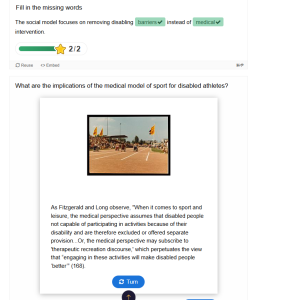
Exercise 5: Notebook Prompt
What do Fitzgerald and Long identify as barriers to inclusion and how might these apply to sport in particular?
The authors explain barriers to inclusion as inaccessible transport, buildings and amenities, lack of opportunity and prejudicial attitudes. These can operate as barriers to sport in particular due to these components in sport and recreation centers to not be accessible. For instance, many children in general do not live close to a sports facility, therefore, if a disabled child wanted to go and play a sport, they would have to take public transport, which is not very accessible for disabled people and can act as an inhibitor to their participation. Additionally, sports centers may not have the appropriate ramps to access their facility, and additionally, they may not have the equipment, amenities or structuring to accommodate the needs of a disabled child who wants to participate in sports. Moreover, the existence of disability friendly sports leagues is very rare and far between. People with disabilities who want to partake in a team sport would either have to travel to a different city to participate or make one themself, which can be extremely difficult or in many instances impossible. The lack of opportunity can be inhibitory towards accessing sport. Finally, prejudiced ideas of disabled people can make them feel unwelcome and discriminated against. Not creating a welcoming environment can make disabled people scared and insecure, limiting their desire to participate.
C) Inclusion, Integration, Separation
Exercise 6: Complete the Activities
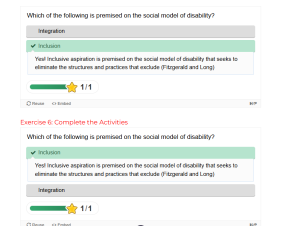
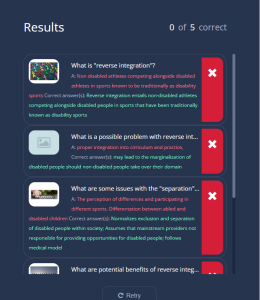
Exercise 7: Notebook Prompt
Choose ONE of the three questions Fitzgerald and Long argue disability sport needs to address and record your thoughts in your Notebook.
- Should sport be grouped by ability or disability?
- Is sport for participation or competition?
- Should sport competitions be integrated?
I believe that sport doesn’t have to be black and white and can be based on the athletes preference. I think the existence of ability, disability and combined sports groups should be offered and accessible to whomever desires. If there are able bodied athletes that want to play with other able bodied athletes, I feel as though that should be offered, along with disabled athletes playing specialized sports for their disability if they desire. However, I also believe a combined sports team of both abled and disabled athletes should be offered. If there is an instance where an able bodied sibling or friend wants to play with their disabled sibling or friend, that opportunity for combined participation should be provided and accommodated for. It would allow for disabled people to feel as though they are a part of the norm and not needed to be accommodated for, along with providing them with the ability to chose for their comfort or competitiveness. By providing a space for all individuals, it would provide the opportunity for them to feel included in any space they so desire.
|
Part Two: Making Connections
A) Gender, Sport and Disability
Exercise 8: Complete the Activity
The paradox that sportswomen habitually face (as the authors observe, this isn’t confined to disabled sportswomen) involves the expectation they will be successful in a ‘masculine’ environment while complying with femininity norms in order to be recognized as a woman.
True or false?
Take a moment to reflect on this paradox below (optional).
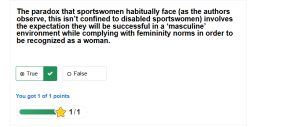
| This paradox that women are expected to maintain femininity norms while in a masculine environment in order to be successful limits their capacities within their sport, and causes them to face external pressure in regards to not only their professional ability, but also their appearance and coherence with gender norms. It causes women to face further discrimination and surveillance by sport officials, other athletes and society as a whole. A woman could have immense athletic talent, however if they don’t cohere with what a “woman should look like”, their abilities are completely disregarded. This paradox causes for women to face unfair expectations, while having to uphold these expectations in order to be successful. |
B) Masculinity, Disability, and Murderball
Exercise 9: Notebook/Padlet Prompt
Watch the film, Murderball and respond to the question in the padlet below (you will have an opportunity to return to the film at the end of this module).
The authors of “Cripping Sport and Physical Activity: An Intersectional Approach to Gender and Disability” observe that the “gendered performance of the wheelchair rugby players can…be interpreted as a form of resistance to marginalized masculinity” (332) but also point out that it may reinforce “ableist norms of masculinity.” After viewing the film, which argument do you agree with?
a) Murderball celebrates a kind of resistance to marginalized masculinity
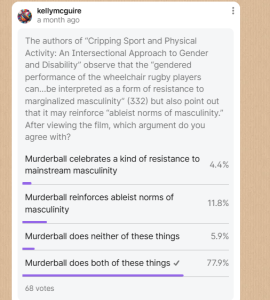
I believe that murderball both resists and reinforces norms of masculinity. It rejects norms of masculinity and celebrates marginalized masculinity through their abilities of support and solidarity between the men on the murderball team, where they are able to celebrate their athleticism in wheelchair rugby. They do not feel less than or inadequate in their athletic ability due to their disability, and instead embrace the sport and use it as a sense of pride. They challenge stereotypes associated with having a disability and instead reform aspects of their masculine identity to include their disability. However, it also reinforces forms of ableist masculinity through problems of aggression, dominating conversation and misogyny. The men on the team also adopt a very masculine persona that reinforces their behaviors as being typically masculine and aggressive. They also speak of their sexuality and sexual experience in a very typical masculine way. Murderball provides a basis for the men on the team to exert their aggression and domineering personality. Overall, I believe that murderball poses as a space for male athletes to both celebrate their form of marginalized masculinity but also adhere to ableist forms of masculinity aswell through its aggressive and domineering nature.
|
Section Three: Taking a Shot
A) Resistance
B) Calling out Supercrip
Exercise 10: Mini Assignment (worth 5% in addition to the module grade)
1) Do you agree with the critique of the “supercrip” narrative in this video? Why or why not? Find an example of the “supercrip” Paralympian in the 2024 Paris Paralympics or Special Olympics coverage and explain how it works.
| I do to some degree agree with the critique of the “super crip” narrative in the video. While I do understand the notion of transcending your disability by participating in sports and how disabled people were treated as the exception in sports due to playing while having a disability, I also understand its benefit and positive messaging. The video not only showcased athletes but also featured ordinary people, including mothers, buying and pumping gas and brushing their teeth. Instead of it transcending their disability, I felt as though it was displaying the possibility of still being able to do things, small or large, while having a disability and learning to work alongside it. I also disagree with the notion that the video showcased that every person with a disability has the desire to become a Paralympian eventually. The video did not reinforce the concept that becoming a Paralympian would bypass your disability status, I feel as though the video was encapsulating the concept of “yes you can” while having a disability and that the possibility of working along side it is more than possible. While I do not have a disability and cannot speak on it from personal experience or opinion, as a whole, I both agree and disagree with the critique of the video.
For the 2024 Paralympic games, they released an advert entitled “We All Stand Together,” where the opening of the video is animated and childlike, and then changes to real life when a disabled boxing athlete gets punched in the chest with the caption “They are not just playing games”. I feel this advert plays into the supercrip idea through its infantilization of the athletes through its animated beginning, and it plays into the concept of acknowledging their disability as outside the norm, and reinforces their conceived capability through changing the style to be real life. It poses the disabled athletes as super crips through changing the scene of the advert, and displaying their athleticism as exceptional. “They’re not just playing games” displays the athletes as more than regular athletes due to their disability and poses their efforts as breaking past the norm.
|
2) Does the film Murderball play into the supercrip narrative in your opinion? How does gender inform supercrip (read this blog for some ideas)?
(300 words for each response)
| I feel as though components of the film “Murderball” do play into the concepts of super crip. Aspects of the editing, music, and chosen clips play into their extraordinary ability to participate in a high-contact sport. It recognizes that prior conceptions of paraplegics and their disability cause them to be structured as fragile and in need of constant assistance. The hardcore music and editing play into their rugged persona and the physicality of the sport. Additionally, by repeatedly going over the reasons why the athletes are paraplegic in the first place, it perpetuates the idea that they have overcome great adversity and have made a life for themself regardless of their disability. This way of displaying their greatness entangles it alongside their disability instead of recognizing their athleticism outside of their perceived capabilities. The entire film operates as a method of inspiration for people and hope, instead of just displaying their experiences playing Murderball.
I feel that gender ties into the idea of “super crip” as being disabled inhibits the social norm of what masculinity and femininity should look like. Many of the athletes in the film were seen as intimidating, jocks and true athletes regardless of their disability, and that was seen as exceptional. The concept of being able to obtain a form of masculinity regardless of your physical ability ties into the idea of super crip because they have been able to step outside of their disability and actualize what society believes as “normal”. For instance, in Murderball, the athletes uphold this perceived notion of masculinity through being aggressive and talking about sex, which reinforces their perception of being “just like us”. The super crip idea results in the athlete being extortionary by participating in sport and upholding recognized conceptions of gender expression at the same time. Overall, I believe that murderball displays the realities of the super crip idea being closely related to masculinity expression through its display of the athletes aggressive and competitive nature.
|
Extra Credit Option
3) How does the film model resistance to both disability and gender norms, and in what ways do the athletes redefine or subvert societal expectations of strength, independence, and masculinity?
Within the film, I believe a model resistance to both disability and gender norms is displayed through how the athletes speak about their experience in the sport and how they have developed an identity outside of their disability and ableist masculinity. While their disability is a key component of who they are, they do not recognize it as a consistent inhibitor to their daily lives and life satisfaction. They recognize the first two years after becoming disabled as the hardest component of relearning how to live, however, they all recognize their desire and work towards becoming independent. Additionally, they also combat gender norms through being confident in their abilities as a disabled person, and can still feel a sense of pride while being shorter and possibly not as adept as other people. Typical masculinity reinforces the concept that they would be unable to participate in sports or provide for themselves because they do not abide by what a man should “look like”. However, the male athletes in Murderball exude confidence in their capabilities and often pride themselves on being able to provide for themselves and the people they care about.
Continuously, the athletes redefine or subvert societal expectations of strength, independence, and masculinity through deriving pride from proving themself and subverting expectations of a disabled person in need of assistance and unable to uphold expectations of the masculine identity. The common social idea of people with disabilities is that they need constant assistance and are incapable of providing for themself. The athletes in the video subvert these expectations by being almost completely independent and finding pride in their disability and the sport they play. Instead of succumbing to the harmful expectations that society upholds about disabled people, the athletes instead create systems of mutual support within their teams, can care for themselves, derive excitement and fulfillment from their sport, and express components of their masculinity without it being hindered by being paraplegic. In general, the athletes transcend social expectations of strength, independence and masculinity through the social support of their teams and deriving strength from their athleticism.

